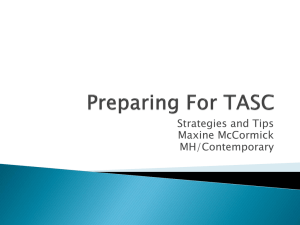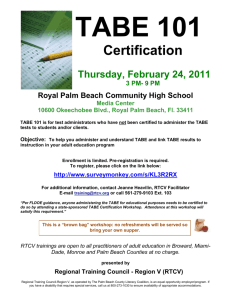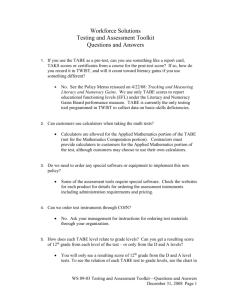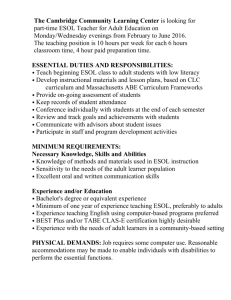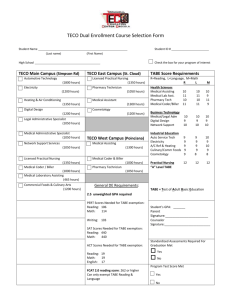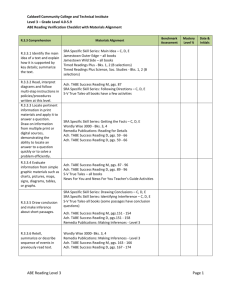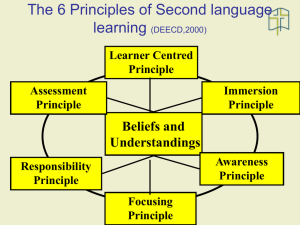TABE CLAS-E Reading Assessment - Massachusetts Department of
advertisement
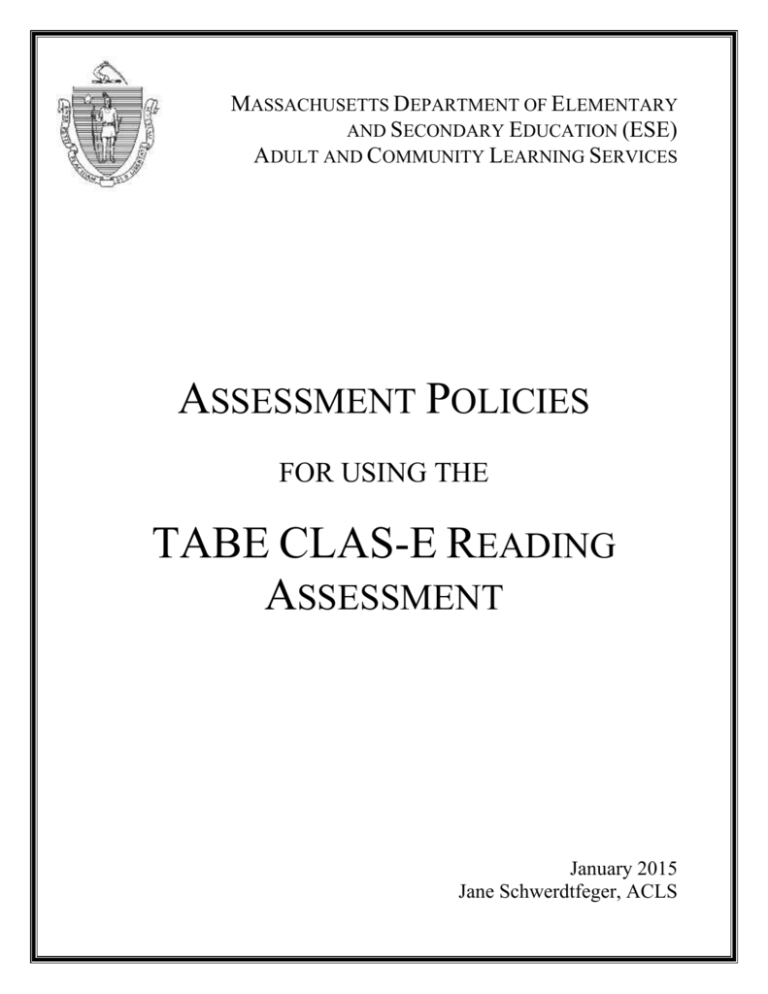
MASSACHUSETTS DEPARTMENT OF ELEMENTARY AND SECONDARY EDUCATION (ESE) ADULT AND COMMUNITY LEARNING SERVICES ASSESSMENT POLICIES FOR USING THE TABE CLAS-E READING ASSESSMENT January 2015 Jane Schwerdtfeger, ACLS TABLE OF CONTENTS TABLE OF CONTENTS ................................................................................................................ 2 General Overview of Learning Gains Assessments........................................................................ 3 Overview of the TABE CLAS-E Reading Assessment .................................................................. 4 Before Administering the CLAS-E Reading Assessment .............................................................. 4 Required Staff Training .............................................................................................................. 4 Certification and Annual Recertification .................................................................................... 4 Required Test Materials .............................................................................................................. 5 Student Placement and When to Administer .............................................................................. 5 Student Primary Assessment Area May Change in Fiscal Year ................................................. 5 Programs Enrolling Students after April 1 May Receive Credit for Post Tests and Learning Gains, under Certain Conditions ................................................................................................. 5 Test Accommodations ................................................................................................................ 6 Pre- and Post-Testing Interval Varies by Intensity of Class Hours ............................................ 6 When to Alternate CLAS-E Reading Test Levels and Forms .................................................... 6 Co-enrolled Learners .................................................................................................................. 7 Cognos Report of All Co-Enrolled Students at a Site................................................................. 7 Test Security ............................................................................................................................... 8 During CLAS-E Reading Administration....................................................................................... 8 Who May Administer ................................................................................................................. 8 Use of the CLAS-E Locator ........................................................................................................ 8 Use the Statewide SABES Developed CLAS-E Locator Answer Booklet and Reading Assessment Answer Sheets Only ................................................................................................ 8 Following Test Administration Procedures ................................................................................ 9 Using Assessment Reports for Tracking When to Post-Test ...................................................... 9 Test Conditions ........................................................................................................................... 9 After Administering the CLAS-E Reading Assessment ............................................................... 10 Scoring the CLAS-E Reading Tests ......................................................................................... 10 Programs are Strongly Encouraged to Use the Guidelines for Retesting with TABE CLAS-E Reading Assessment ................................................................................................................. 10 TABE CLAS-E Reading Assessment Retesting Guidelines Chart........................................... 11 Score Reporting ........................................................................................................................ 11 Exit Criteria for NRS Advanced ESL Level Students .............................................................. 11 CLAS-E Reading Scale Scores for NRS Educational Functioning Levels Chart .................... 11 CLAS-E Reading Scale Scores’ Correlation to NRS (National Reporting System) EFL (Educational Functioning Levels) and SPL (Student Performance Levels) Chart ................... 12 Measuring Learner Gains .......................................................................................................... 12 Copying over CLAS-E Reading Scores to the Next Fiscal Year.............................................. 13 Questions....................................................................................................................................... 13 Assessment Policies for Using the TABE CLAS-E Reading Assessment, 2014 Massachusetts Department of Elementary and Secondary Education, Adult and Community Learning Services 2 General Overview of Learning Gains Assessments The Massachusetts Department of Elementary and Secondary Education (ESE) is mandated by the US Department of Education to use valid and reliable assessments to report students’ completion of educational functioning levels. ACLS requires programs use four ABE standardized assessments, depending on the classes they offer: the Massachusetts Adult Proficiency Test (MAPT), the TABE Forms 9/10, Best Plus, and the TABE CLAS-E. Massachusetts’s process for using required assessments for measuring learning gains: 1. Learning gains are based on the first test and the last test given in a fiscal year 2. Class Placement (after intake, using any assessment other than MAPT) 3. Pre-test (within 2-4 weeks of class placement) 4. Formative assessment using teacher-made or other assessments during class to determine if students mastered what was taught (ongoing) 5. Optional Mid-year Test (after 65 hours of instruction; test no more than three times per year) 6. Post-test (after 65 hours and before June 30; programs may not test more than three times per year) 7. All Assessment administered must be entered in SMARTT. Required Assessments Skills tested MAPT ABE Reading and Math ABE Writing (Language subtest) Literacy Level Reading ESOL Speaking and Listening ESOL Writing ESOL Reading ESOL TABE 9/10, Levels E, M, D, A ABE Reading and Math TABE 9/10, Level L BEST Plus TABE CLAS-E Writing Assessment only TABE CLAS-E Reading Assessment only Which Programs Use ABE ABE ABE Programs in Correctional Institutions, some Workplace without access to computers ABE learners below GLE 2 ESOL ESOL For assessments to be accurate, they must be administered and scored according to test developers’ instructions. If staff make what may seem like small changes to test administration or scoring (such as giving test directions differently or diverging from a test’s rubric when scoring), test scores lose their accuracy. These changes affect the instruction learners may need and slow them down in achieving their goals. It also adversely affects the accuracy of statewide scores that ACLS uses to base annual state projections of learning gains for US DOE. Formative assessments are also crucial to instruction and learner gains. They include authentic, teacher-made, task-based activities and products, etc. They test various skills determined by the teacher’s learning objectives and should include content and skills from the Massachusetts ABE Curriculum Framework for ESOL and the College and Career Readiness Standards for Adult Education (CCRSAE). Formative assessments are important because they indicate what students learned (and did not learn) and they guide what to teach next. They also involve students in the learning process, which improves motivation, persistence, and retention. Assessment Policies for Using the TABE CLAS-E Reading Assessment, 2014 Massachusetts Department of Elementary and Secondary Education, Adult and Community Learning Services 3 Overview of the TABE CLAS-E Reading Assessment The state’s assessment policy requires programs to use the TABE CLAS-E Reading Assessment for the following adult learners: ESOL students (SPL 0-6) whose goal is to improve their reading skills The state’s assessment policy requires programs to use the BEST Plus test (computer-adaptive version) for the following learners enrolled in ESOL classes: ESOL students (SPL 0-6) whose goal is to improve their oral proficiency The state’s assessment policy requires programs to use the TABE CLAS-E Writing Assessment for the following adult learners: ESOL students (SPL 0-6) whose goal is to improve their writing skills Primary instruction provided by the volunteer program English at Large The following program types may use either the TABE CLAS-E Reading or Writing Assessment or BEST Plus, depending on their learner’s goals: Workplace Education (ESOL) Programs Distance Learning (ESOL) Programs Students enrolled in Pre-Literacy ESOL classes, Levels 1, 2 and 3 Before Administering the CLAS-E Reading Assessment Required Staff Training A minimum of two staff per program must be trained to administer and score the CLAS-E Reading assessment before any testing of students can begin. Programs offering ESOL classes must maintain at least two CLAS-E test administrators at all times. Trained staff may not train fellow staff members at their programs. There are two options for training: Practitioners who have been certified by SABES (System for Adult Basic Education Support) to administer CLAS-E need to take a short online training which concludes with a short test. Staff that successfully pass the short test will be certified to administer and score the CLAS-E Reading. Practitioners that have not been certified to administer CLAS-E Writing, including those certified to administer the TABE 9/10, need to attend a face-to-face training offered by SABES. Certification and Annual Recertification Concluding the training, there will be a short test. Staff successfully passing the short test will be certified to administer and score the CLAS-E Reading. Please note: no certificates will be given; please retain your email notification. Trainees not passing the test will be given a second and final opportunity to pass it. There is no annual recertification process. Assessment Policies for Using the TABE CLAS-E Reading Assessment, 2014 Massachusetts Department of Elementary and Secondary Education, Adult and Community Learning Services 4 Required Test Materials Programs that have been using the CLAS-E Writing assessment should already have the items in this list. If not, the following Test materials may be purchased at http://www.ctb.com/ctb.com/control/childNodesViewAction?categoryId=1145&adjBrd=Y 1. CLAS-E Locator Test (includes the test questions) 2. CLAS-E Locator Test Directions 3. CLAS-E Replacement Test Books, Forms A and B, Levels 1 through 4 4. CLAS-E Test Directions for Forms A and B, Levels 1 through 4 5. CLAS-E Scoring Tables Book, Forms A/B The following required test materials may be acquired from the CLAS-E Reading training or from Joan Ford, the SABES assessment director, at joan.ford@bristolcc.edu: Tips for Taking the TABE CLAS-E (for test-takers) and test administrator directions 1. Adapted CLAS-E Locator Test Answer Booklet for Statewide Use (use this Answer Booklet instead of the CTB McGraw-Hill CLAS-E Locator Test Answer Booklet) 2. Adapted TABE CLAS-E Locator Test Directions 3. SABES-developed Answer Sheet for Levels 1-4 4. SABES-developed alternative directions for Answer Sheet for Levels 1-4 Student Placement and When to Administer Programs may use any placement tests they choose. The CLAS-E Reading assessment may be given at intake, and may be given as both the placement and pre-test. It may also be administered in class any time within 2-4 weeks of class placement, but no later than 4 weeks. Student Primary Assessment Area May Change in Fiscal Year Either BEST Plus, CLAS-E Reading, or CLAS-E Writing must be selected as the primary assessment to report educational gain for students in ESOL classes. Programs are required to administer only one of the three, but more than one assessment may be administered if the program wishes, with one test counting as the student’s primary assessment and entered into SMARTT. A student’s Primary Assessment Area may change during the fiscal year Learners who are co-enrolled may have different primary assessment areas at the different programs where they are enrolled to maximize their time at each program. (See the section on co-enrolled learners for more information). Programs Enrolling Students after April 1 May Receive Credit for Post Tests and Learning Gains, under Certain Conditions Students who are enrolled in a program on April 1 or after and who have 65 hours of attended instruction between April 1 and June 30 may take a pre- and a post-test. The learner’s post-test will be added to the program’s percentage of pre-/post-tested learners. Any type of attended hours qualify, including rate-base class hours, non rate-base class hours, match hours, and distance learning hours. In addition, if students have attended 65 hours of instruction between April 1 and June 30 and make learning gains, these gains will be added to the program’s percentage of learner gains. Assessment Policies for Using the TABE CLAS-E Reading Assessment, 2014 Massachusetts Department of Elementary and Secondary Education, Adult and Community Learning Services 5 Test Accommodations An adult learner with a disability must provide the ABE program with disability-related documentation if he/she requires accommodations. If a counselor or other program staff person determines through a screening that there is a strong possibility the learner has a learning disability or other disability, a formal assessment may be undertaken. A formal assessment of a learning disability must be administered by a licensed professional (e.g., psychologist, school psychologist, or psychiatrist) and is valid for 5 years from the date of the formal assessment. In some cases, a “licensed professional” may be a speech, vocational, physical, or occupational therapist with verification by a licensed medical doctor, psychiatrist, or psychologist. An IEP (Individual Education Plan) is not a documented formal diagnosis of a learning disability. “Disability-related documentation” includes educational assessments, or an Individual Education Plan (IEP) developed by the public school system to document a person’s disability for an accommodation in the ABE program. For more information about modifications and accommodations relating to ABE instruction, please refer to pages 13-15 in the ACLS Disability Guidelines, at http://www.doe.mass.edu/acls/disability/guidelines.doc. Any student may be given the large print version of the TABE CLAS-E Reading assessment if needed. Contact Joan Ford at joan.ford@bristolcc.edu for more information or to borrow it. For any questions, concerns, or if staff have a student who should receive accommodations on the CLAS-E Reading assessment, please contact April Zenisky-Laguilles at aclstesthelp@educ.umass.edu. Pre- and Post-Testing Interval Varies by Intensity of Class Hours Programs need to pre- and post-test enrolled students each fiscal year in order to capture student educational gain. The general recommendation is to post-test after an interval of 65 hours of instruction. Programs may not test learners more than three times in a fiscal year. The test administered for the pre-test must remain the same for the post-test (e.g., one may not pre-test with the CLAS-E Writing and post-test with the CLAS-E Reading or the BEST Plus). When to Alternate CLAS-E Reading Test Levels and Forms The CLAS-E Interview Part B and the Locator Test Part 1 must be used for the first CLAS-E Reading test given to learners. The Locator does not need to be given on subsequent tests. Different levels of the CLAS-E may be given for initial, optional mid-year, and post-testing. For example, a learner may be pre-tested at level 2, and post-tested at level 3. All levels of CLAS-E are calibrated on the same scale, so results may be compared across levels. When testing students at mid-year (optional) and/or for the end-of-year (post-test), alternate test forms must be given so that no student gets the same test form twice in a row. It would be easy for learners to remember the form from one test administration to the next. If a student is functioning at the same level, switch Forms (e.g., Level 3, Form A to Level 3 Form B); If she/he has shown strong progress in class, move to the test at the next level with the same form (e.g., Level 3 to 4, Form A). Assessment Policies for Using the TABE CLAS-E Reading Assessment, 2014 Massachusetts Department of Elementary and Secondary Education, Adult and Community Learning Services 6 It is permissible to pre-test with Form A, administer a mid-year optional test with Form B, and post-test with Form A within a fiscal year. Co-enrolled Learners Assessment information for learners co-enrolled or transferred will appear in SMARTT so that all programs involved with those students can use it. A student’s required assessment (e.g., CLAS-E Reading or Writing, BEST Plus, MAPT, TABE 9/10) will appear in SMARTT at all sites where individual students are enrolled, regardless of the site where a student took the test. This feature makes it easier for programs to enroll these students and get them settled in class. The assessments are color-coded purple in the SMARTT Student Assessment Screen to show where the test was taken. The Primary Assessment Area may be set at all sites within the current fiscal year, and may vary between sites. (For example, a student may have a primary assessment area of math at one site, and reading at a site at which he/she is co-enrolled). The copy icon will appear next to all May/June tests so that users may copy the last test taken from any site to their own site in the new Fiscal Year. A link labeled “Other Site Assessments” located on the SMARTT “Welcome Screen” shows the list of co-enrolled students who took tests at other sites. There are two panels for current and exited students. Programs may view the list and drill down to the assessment screen to view tests for individual students. Programs may decide if they want to set primary areas for this test. A column also shows if the primary area has been set. This feature allows programs to determine whether or not dually enrolled students need to have another assessment administered immediately. To access the SMARTT Assessment Reports, click on the "Site" link on the left menu in SMARTT, and then click on the "Assessment Report Primary Set" option. The report will list all the tests, dates, forms, and next suggested testing date. Cognos Report of All Co-Enrolled Students at a Site In addition to the SMARTT Student Assessment Screen, there is also a new report in Cognos that allows a program to view all co-enrolled students in a site, sorted by their assessment (e.g., CLAS-E, BEST Plus, etc.) This report will list the co-enrolled student’s name, other site(s) in which the student is co-enrolled, the site at which the test was taken, the date taken, the test name, test form and level, and the test score. This report can be helpful in that the SMARTT Student Assessment Screen lists students individually, while this Cognos report lists all co-enrolled students in a program, filtered by their assessment. To use this report, log on to Cognos http://www.doe.mass.edu/acls/smartt/ using the program’s or an individual Cognos account. Once on the ACLS Homepage, select the tab at the top labeled “Desk Review” and the report on c-enrolled students will be among the reports listed. Assessment Policies for Using the TABE CLAS-E Reading Assessment, 2014 Massachusetts Department of Elementary and Secondary Education, Adult and Community Learning Services 7 To receive a Cognos Account Program staff may use their Program’s Cognos account since every site has one. Staff wishing to have a Cognos account may have their program director request one for him/her, as individual access is at the discretion of the Program Director. Requests for accounts need to be made two weeks prior to when the account is needed. Program directors, please send requests to Sriram Rajan srajan@doe.mass.edu with the following information supplied: Name of staff who will receive the account Email Official Site Name (no acronyms or abbreviations) Role at Program (specify Teacher, Counselor, Site Coordinator, or other) The staff request for what they would like the Cognos User ID to be (e.g., 1st initial and last name, or some other personally meaningful identifier) Users will receive their Cognos account information by email, along with a generic password. When users first log in, they must create their own password. Users need to write down the user ID and password and keep them in a handy place. Users and Programs must manage their own passwords and User IDs; ACLS will not have that information. Test Security All CLAS-E Reading test materials and student test scores must be kept in a secure place. Do not file students’ CLAS-E Reading test answer sheets in their personal portfolio. Staff should, however, share, explain, and discuss scores with students so students can understand and follow their progress. Staff and test administrators may not use CLAS-E test booklets or test items to prepare learners for their CLAS-E tests. The Massachusetts Department of Elementary and Secondary Education reserves the right to immediately terminate the program’s grant if any staff are found to be violating the CLAS-E assessment policy regarding test security. During CLAS-E Reading Administration Who May Administer Certified TABE CLAS-E Reading Test Administrators may administer their own students’ CLAS-E Reading tests. Use of the CLAS-E Locator Learners taking the CLAS-E Reading test for the first time are required to take the CLAS-E Part B Interview/Screening Tool and the Locator, whether or not they have taken CLAS-E writing. Use the Statewide SABES Developed CLAS-E Locator Answer Booklet and Reading Assessment Answer Sheets Only Programs must not use any program- or teacher-developed CLAS-E answer sheets because depending on the answer sheet, learners may gain an unfair advantage—or experience a disadvantage—from the program-developed answer sheet. Assessment Policies for Using the TABE CLAS-E Reading Assessment, 2014 Massachusetts Department of Elementary and Secondary Education, Adult and Community Learning Services 8 The test publisher has granted permission for Massachusetts to use SABES-developed answer sheets for both the Locator and the Reading assessment, and programs must only use these two answer sheets in order to maintain consistency and a level playing field for all test-takers. Following Test Administration Procedures Test administrators must administer and score the TABE CLAS-E Reading Assessment test exactly according to the CLAS-E trainings offered by SABES. Test administrators must not deviate from the script or test directions as they are presented in the training in any way. Strictly adhere to the test’s time limits: the Part B Interview/Screening Tool is 5-10 minutes; Locator is 15 minutes, and the Multiple Choice portion of the Reading test is 25 minutes. Using Assessment Reports for Tracking When to Post-Test The SMARTT system generates assessment reports so that a program may track when to administer the next CLAS-E test1. The CLAS-E report will list the date administered for the previous fiscal year, either the copied May/June test or a new pre-test and optional mid-year test for the current fiscal year. The assessment reports may also be used to check which learners have not yet been post-tested near the end of the fiscal year. Any of the reports may be exported into Excel. To access these reports, go into SMARTT, select the “Site” link on the left menu in SMARTT and select “Assessment Report Primary Set.” To see CLAS-E Reading assessments taken by all learners at the program regardless of their Primary Assessment Area, instead select “CLAS-E Reading Report” (shown in green) below the “Assessment Report Primary Set.” Any tests started before the end of the fiscal year but completed after June 30th will be counted as pre-tests in the next fiscal year. Test Conditions The testing location must be quiet and comfortable so learners will not be distracted by their surroundings while taking the test. Learners may be tested in a quiet computer lab, empty classroom, office, or other space. Learners may not be tested in an occupied classroom or space where other students are in class or talking. 1 Note that the date for the next assessment to be taken is based on 65 hours of instruction. Programs may not test learners more than three times per fiscal year. Assessment Policies for Using the TABE CLAS-E Reading Assessment, 2014 Massachusetts Department of Elementary and Secondary Education, Adult and Community Learning Services 9 After Administering the CLAS-E Reading Assessment Scoring the CLAS-E Reading Tests Certified CLAS-E Reading Test Administrators may score their own students’ CLAS-E Reading tests. Programs are Strongly Encouraged to Use the Guidelines for Retesting with TABE CLASE Reading Assessment The CLAS-E Reading Retesting Guidelines are intended to help programs determine either 1) if retesting using a different Reading level is needed, or 2) if student’s test scores are a reasonably accurate reflection of their abilities. Programs have encountered difficulty in using learner’s TABE CLAS-E Writing scores for evaluating gain between pre- and post-tests, and are also likely to encounter difficulty with the CLAS-E Reading scores. It can be difficult to determine when retesting (using a different TABE CLAS-E Reading level) is appropriate for a pre-test, and when a student’s score is a reasonably accurate reflection of his/her abilities. Important Note: Checking for Retesting is only needed during the first time a student is tested using the CLAS-E Reading (e.g., at the pre-test). To determine whether a student’s score on their TABE CLAS-E pre-test is a reasonable reflection of that student’s proficiency, compare the student’s scale score from the CLAS-E test to the guidelines below that correspond to the difficulty level of the test taken (1, 2, 3, or 4). For each possible scale score, instructors will be directed to one of three actions: retest immediately using the next lower level of the TABE CLAS-E, not retest at all, or retest immediately using the next higher level of the TABE CLAS-E. The guidelines presented below were developed with careful statistical consideration of the standard error of measurement (SEM)2. The SEM is a statistical estimate of the amount of error to be expected in a particular score from a particular test, and provides the user with a range within which a student’s true score is likely to fall. Lower SEM is associated with more precise measurement while higher SEM means that an individual’s score contains more error and is less reliable. SEM is a reasonable indicator of the reliability of test results. An individual student’s observed score from a single testing experience is likely to fall within one SEM of the student’s true score 68% of the time, and within two SEMs 95% of the time. These guidelines are computed using the statistical properties of the tests to ensure that decisions as to whether or not students should be retested are based on the statistical levels of errors in the scores. SEM is computed as SEM SD 1 r where SD is the standard deviation of the test and r is the reliability. For TABE CLAS-E, reliability coefficients provided by the publisher are KR-20 estimates of internal consistency. SDs and KR-20 estimates are from the TABE Technical Report. The SEM for CLAS-E is computed in Sireci, 2011. 2 Assessment Policies for Using the TABE CLAS-E Reading Assessment, 2014 Massachusetts Department of Elementary and Secondary Education, Adult and Community Learning Services 10 TABE CLAS-E Reading Assessment Retesting Guidelines Chart CLAS-E Level 1 If your student’s scale score is 464 or below, DO NOT RETEST If your student’s scale score is 465 or above, RETEST with LEVEL 2 CLAS-E Level 2 If your student’s scale score is 371 or below, RETEST with LEVEL 1 If your student’s scale score is between 372 and 502, DO NOT RETEST If your student’s scale score is 503 or above, RETEST with LEVEL 3 CLAS-E Level 3 If your student’s scale score is 411 or below, RETEST with LEVEL 2 If your student’s scale score is between 412 and 531, DO NOT RETEST If your student’s scale score is 532 or above, RETEST with LEVEL 4 CLAS-E Level 4 If your student’s scale score is 485 or below, RETEST with LEVEL 3 If your student’s scale score is 486 or above, DO NOT RETEST Score Reporting CLAS-E Reading scale scores must be recorded in SMARTT. Scale scores are the type of score used for the CLAS-E, and they are used to compute and derive all other scores associated with the CLAS-E Reading assessment. The SMARTT ABE database will translate the scale scores into the levels stipulated by the federal National Reporting System (NRS). Programs may generate reports that portray student educational functioning levels and gains using SMARTT. Exit Criteria for NRS Advanced ESL Level Students A scale score of 588 and above in CLAS-E Reading Level 4 (both Forms A and B) is the exit criteria for students in the Advanced ESL level. Once students attain a score of 588, they may not remain in the program the following fiscal year if their primary assessment area is ESOL Reading. CLAS-E Reading Scale Scores for NRS Educational Functioning Levels Chart ESL Educational Functioning Level Beginning ESL Literacy Low Beginning ESL High Beginning ESL Low Intermediate ESL High Intermediate ESL Advanced ESL TABE Clas E Reading Scale Scores 250 – 392 393 – 436 437 – 476 477 – 508 509 – 557 558 and above SPL Level 0–1 2 3 4 5 6 Assessment Policies for Using the TABE CLAS-E Reading Assessment, 2014 Massachusetts Department of Elementary and Secondary Education, Adult and Community Learning Services 11 Following is another chart indicating how the CLAS-E test levels 1-4 correspond to the test’s scale scores, the SPL and NRS levels: CLAS-E Reading Scale Scores’ Correlation to NRS (National Reporting System) EFL (Educational Functioning Levels) and SPL (Student Performance Levels) Chart TABE CLASE Level SPL Level NRS EFL Level 1 CLAS-E Reading Scale Scores 250 – 392 393 – 436 SPL 0 – 1 SPL 2 Beginning ESL Literacy Low Beginning ESL 2 393 – 436 437 – 476 SPL 2 SPL 3 Low Beginning ESL High Beginning ESL 3 437 – 476 477 – 508 SPL 3 SPL 4 High Beginning ESL Low Intermediate ESL 4 509 – 557 558 and above SPL 5 SPL 6 High Intermediate ESL Advanced ESL Measuring Learner Gains Learning gains are calculated each fiscal year from pre- and post-testing and based on learners’ first (pre-test) and last test. Massachusetts measures learners’ educational gain in two different ways. First, Massachusetts reports the number of ESOL learners completing or advancing one or more Educational Functioning Levels (EFL) as defined by the US Department of Education’s National Reporting System (NRS). Massachusetts is required by the US Department of Education to not only report learning gains based on EFL completion rates, but also to use EFL completion rates as a measure of program performance. In addition to measuring learning gains by EFL completion rates, Massachusetts measures “meaningful educational gain.” Meaningful educational gain is measured solely by the improvement in test scores between the pre- and post-test (e.g., the first and last test) and does not take into consideration Educational Functioning Levels. The amount of scale score points that indicate meaningful educational gain is 24 or more scale score points. Measuring Completion of Educational Functioning Levels for the Federal US Department of Education (National Reporting System, Federal Report Table 4) The National Reporting System (NRS) requires that all students who have 12 hours or more of attendance be included in all Federal Report tables, including those reporting pre- and post-tested learners and those making gains by completing an Educational Functioning Level. Assessment Policies for Using the TABE CLAS-E Reading Assessment, 2014 Massachusetts Department of Elementary and Secondary Education, Adult and Community Learning Services 12 Copying over CLAS-E Reading Scores to the Next Fiscal Year Any CLAS-E Reading tests given to students in May or June may be rolled over to count as the first (pre-) test in the new fiscal year. Program staff may copy the score or give a new test. The copy icon will appear next to all May/June tests so that users may copy the scores from any site to their own site in FY13. The May/June test will then be dated July 1 of the new fiscal year. The July 1 date is colorcoded to let program staff know it was copied. Transitions programs, see specific policies at http://www.doe.mass.edu/acls/assessment/TCCPpolicy.html. Questions Program staff must read the Assessment Updates in the ACLS Monthly Mailings for important new information: http://www.doe.mass.edu/acls/mailings. Please contact April Zenisky-Laguilles at aclstesthelp@educ.umass.edu, or Joan Ford, SABES director of assessment professional development, at Bristol Community College, 777 Elsbree Street, Building Q, Fall River, MA 02720; Phone: (774) 357-2190; Email: joan.ford@bristolcc.edu; Fax: (508) 730-3280. For policy-related questions, please contact Dana Varzan-Parker, Program and Assessment Specialist, at Adult and Community Learning Services (ACLS), 75 Pleasant Street, Malden, MA 02148; Phone: 781-338-3811; Email: dvarzan-parker@doe.mass.edu; Fax: (781) 338-3394. Assessment Policies for Using the TABE CLAS-E Reading Assessment, 2014 Massachusetts Department of Elementary and Secondary Education, Adult and Community Learning Services 13
